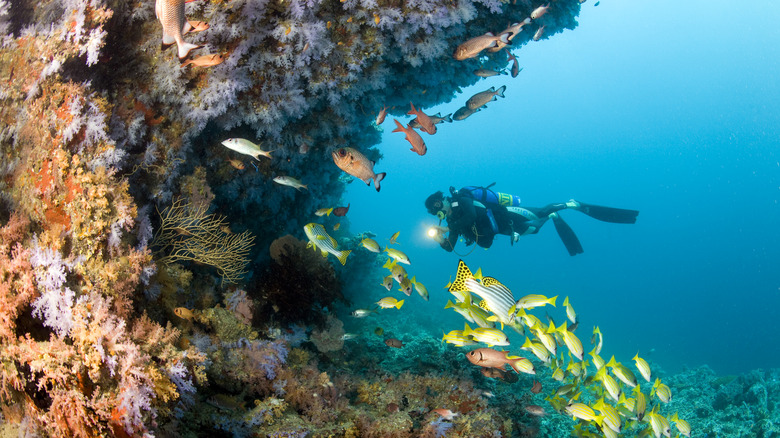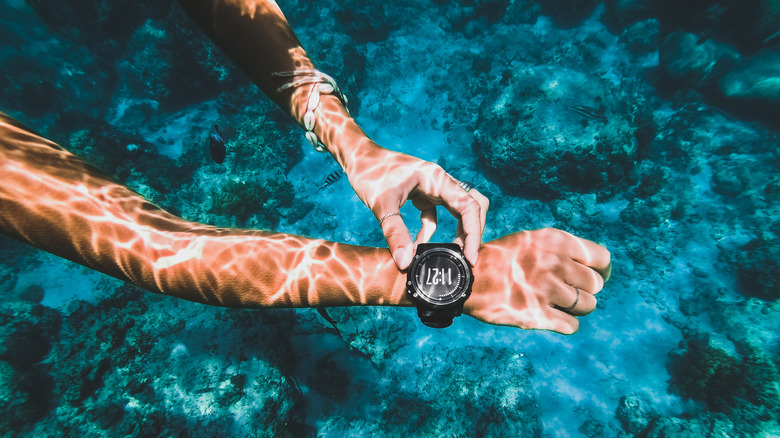The Common Vacation Activity That Is Dangerous To Do Before A Flight
Being in an airplane is superhuman. It involves flying inside an ultra-pressurized engineered metal tube with a humidity level dryer than the Sahara Desert at nearly 600 miles per hour and up to 39,000 feet in the stratosphere. Do you know what else is equally superhuman? Scuba diving. Many are willing to fly several miles to places like Rangiroa Island in French Polynesia or Pulau Tioman in Malaysia to experience some of the world's best scuba diving on their vacation. Once you try scuba diving, snorkeling becomes incomparable: exploring underwater realms, encountering marine life, and experiencing the beauty of the ocean without having to come up for air is sublime. However, there's an important caveat for travelers: scuba diving before a flight can be dangerous.
Scuba diving involves breathing compressed air underwater, which affects the body differently compared to breathing at sea level. There's a misconception that divers breathe pure oxygen from the tank — scuba divers use regular air, like the one above water, which is made of 21% oxygen and 79% nitrogen. Some divers use enriched air nitrox, known as EANx, which has a higher concentration of oxygen in the tank (32% or 36%), allowing longer dives. When divers breathe compressed air at depth, the nitrogen dissolves into their blood and tissues due to the increased pressure underwater. For every 30 feet of depth, the pressure increases by one bar. The deeper and longer the dive, the more nitrogen is absorbed into the body.
Decompression sickness and flying after scuba
Scuba diving is the equivalent of flying in an airplane (or outer space!), but underwater — and what goes down must eventually come up. When a diver ascends to the surface, the pressure decreases, and the nitrogen gases begin to leave the body. This process is generally slow and controlled, but if a diver ascends too rapidly, the built-up nitrogen gas bubbles won't get released properly, which can be painful or even fatal. As divers return to normal pressure above water, they still have residual nitrogen bubbles in their bloodstream and tissues. If they fly shortly after, the change in altitude and reduced cabin pressure in an airplane might cause the bubbles to expand dangerously. This can result in a condition known as decompression sickness (DCS) or the bends.
Decompression sickness occurs when these nitrogen bubbles cause a range of symptoms, including joint pain, dizziness, numbing, tingling, headaches, chest pain, and even difficulty urinating or breathing. Symptoms of the bends usually start within 15 minutes to 12 hours after a dive, but sometimes, they can appear even 36 hours later. In severe cases, DCS can be life-threatening. Unfortunately, divers are more likely to fly while they already have DCS than suddenly develop those symptoms aboard the plane or post flight. The severity of DCS — mild Type 1 or serious Type 2 — depends on the depth and duration of the dive, the number of dives, the diver's physical condition, and how soon they fly after diving.
Tips for traveling divers
To minimize the risk of decompression sickness, divers should follow established guidelines regarding flying after diving. The Divers Alert Network (DAN) and other diving organizations, like the Professional Association Of Diving Instructors (PADI), recommend specific time intervals between the last dive and flying. The general rule is to wait at least 12 to 18 hours after a single no-decompression dive and 18 to 24 hours after multiple dives or decompression dives before boarding a flight. These intervals allow sufficient time for the body to eliminate any excess nitrogen. To really stay on the safe side, a 24-hour surface break post-scuba and before flying is ideal. Also, be careful about taking this common medication before a flight.
On your vacation, resist the temptation to squeeze in an extra dive or two the day or hours before your flight. Ensure that your travel plans include the recommended time interval between your last scuba dive and your flight. While diving, use a dive computer to keep track of your dive profiles, especially depth and duration. This nifty, indispensable diving gadget will help you manage your nitrogen levels and provide real-time information on safe ascent rates and surface intervals. Make sure to stay hydrated, as water will help your body eliminate inert nitrogen. Avoid alcohol and excessive caffeine. If you experience any symptoms of DCS, seek medical attention immediately and make sure to buy good travel insurance.


